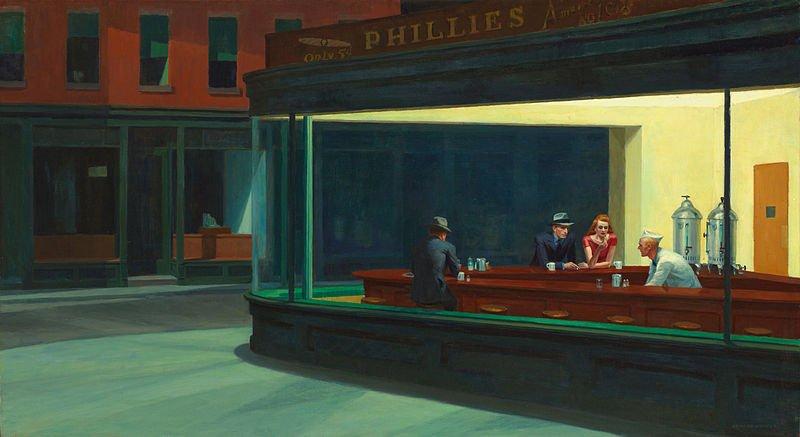In this painting by Edward Hopper called Nighthawks, 1942, we see an example from a school of painters who became known as Realist Painters, Realist art represented subject matter truthfully without artificiality and avoiding artistic conventions, implausible, exotic and supernatural elements. American scenes and symbols were the subjects of their work.
Nighthawks is one of Hopper’s most well known paintings, in it we see an empty city street at night with an interior containing four figures. We can imagine that we view the painting as though it is a scene on a cinema screen, our eyes are drawn to the figures in the cafe. Hopper spent a long time before making a start on the canvas, working slowly and methodically he uses shapes and diagonals which are carefully constructed helped by referring to preparatory sketches, I imagine his sketches would have more spontaneity, the figures are placed in a way to create the proper balance between them and the environmnet. Light and dark were used to great effect, the fluorescent lighting created an eerie glow rather like a beacon, saturated oil colour provides the mood. The couple and another customer sit while the waiter stands head raised, ready to take orders, but they are lost in ther own thoughts, there is no sign of them communicating with each other, the light playing on the simplified shapes gives the work a kind of beauty, warmth in the atmosphere is missing.
Hopper painted his feelings about middle class conformity, lives that seemed dull and stagnant. He denied that he was using symbols though many art critics thought that his images reflected the ‘national spiritual vacuum’, he did admit that perhaps he was using them unconsciously, he was aware of Freud’s work and wrote ‘so much of every art is an explanation of the subconscious that it seems to me most of all the important questions are put there unconsciously and little of importance to the conscious intellect’.
Much of his work was influenced by the themes of an earler painter called Burchfield who created symbolic projections of a private ennui and impenetrable monotony present in the large American cities at the time. Anonymous brick house fronts, neon signs, cinema interiors, even the pavements, diners and petrol pumps were portrayed. Art critics described Nighthawks as a metaphor for loneliness and life robbed of relevance to feeling. Hopper disagreed saying that the characters were like predators in the night, hence the title he gave the work, they look sullen as they rest in the characterless surroundings, Hopper managed to create a dream like quality to the painting by the use of colour, light and shadow.
Edward Hopper was born into a Baptist family, his ancestry had some Dutch roots. He was a serious young man wih a good sense of humour, rather reclusive and introvert, he admired French and Russian culture also the paintings of Manet, Degas and Rembrandt. He married a lively young painter, outgoing and fun, but she was prepared to join him in his quiet way of life, she was his model quite often and was probably a model in Nighthawks and Hopper himself too. He was also an etcher and produced posters in WW2. As a painter in watercolours he was also very successful, his images were city scenes and seascapes. He earnt his keep in the early days of his career doing illustrations but disliked the work and was pleased when he could stop. In 1906 he went to Paris, returned to America and exhibited at the Exhibition of Independents in 1910. One of his tutors called Sloan and also the artist Degas used themes like uglines of provincial life or an existance lacking romantic fullfillent, all early influences on Hopper. He later abandoned painting in order to concentrate on etching.

